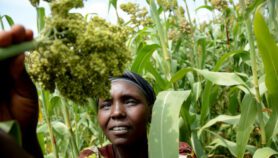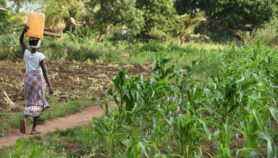By: Yojana Sharma
Send to a friend
The details you provide on this page will not be used to send unsolicited email, and will not be sold to a 3rd party. See privacy policy.
Moves by Canada and Australia to merge their respective development aid agencies into their foreign affairs and trade ministries are being followed closely amid fears that global poverty alleviation aims could be diluted and some of the poorest regions, such as Africa, made a lower priority.
The unexpected announcement of the amalgamation of the Canadian International Development Agency (CIDA) and Department of Foreign Affairs and International Trade into a new body called Foreign Affairs, Trade and Development Canada — came in March 2013. The legislation to enact the change followed swiftly in June, effective a month later.
“There was no prior consultation that we are aware of,” says Anthony Scoggins, director of international programmes at Oxfam Canada.
Canada’s reorganisation of foreign aid administration is largely being carried out behind closed doors, with the new structure still incomplete and its aims and the direction not completely clear to stakeholders.
AusAID no more
Last September, Australia announced the folding of its stand-alone aid agency AusAID into the Department of Foreign Affairs and Trade, one of the first acts of the conservative government, which took office in September 2013.
AusAID ceased to exist as an entity at the end of October 2013 — within weeks of the announcement. The policy was not in any election manifestos.
“There were no indications leading up to the decision, not even within [AusAID] itself. That’s why it came as a shock to everyone in the sector — there hadn’t been any discussions,” says Michelle Higelin, head of programmes for ActionAid Australia.
Although foreign affairs minister Julie Bishop has reaffirmed support for Australian NGOs in various policy statements, the way the merger is being carried out means “there is a lot of uncertainty for all NGOs in Australia”, Higelin tells SciDev.Net. “What doesn’t come as a huge surprise is the desire by the government to be leaner and to cut the costs of the bureaucracy.”
In Canada, a number of NGOs lost their grants as national development aid aims shifted in the years before CIDA was scrapped, according to disparate reports.
Aid became underpinned by a policy to increase engagement with the private sector, and lessen links with multilateral institutions and some NGOs, according to Stephen Brown, a professor of political science at University of Ottawa who has edited a book on CIDA’s effectiveness.
He sees it as “part of a global move, particularly in conservative-dominated countries, to align foreign aid more closely with self-interest and especially commercial self-interest”.
But it is still more common among developed nations for development aid agencies or functions to sit within foreign ministries, Brown says. What matters is whether their purpose is clear and that their development work is carried out, he says.
Aid for trade?
The Australian government has said that the new aid programme will be underpinned by “promoting aid for trade”, says Higelin. “What it hasn’t elaborated on is what that actually means,” she says. “So we are trying to understand what that is.”
Public statements say that development aid is now geared towards “Australia’s national interest”. This includes strengthening partnerships with the private sector aimed at reducing poverty and promoting growth.
But “the private sector message is communicated in an ambiguous way”, says Robin Davies, associate director of the Development Policy Centre at the Australian National University, in Canberra.
“The current mood of the NGO sector in Australia is one of huge uncertainty, but also active engagement in trying to influence the new agenda, to ensure the best possible outcomes for people in poverty,” says Higelin.
Canadian clues
With little to go by, many in Australia are looking to Canada for clues as to how the sudden merger will play out and what it means for development aid priorities. There are many similarities between the countries.
“The two aid agencies are being dismantled rather than merely grafted onto foreign ministries. Even the brands CIDA and AusAID are being deleted,” says Davies. The main difference is that the amalgamation has happened swiftly in Australia, while in Canada it came after a long decline in CIDA, which was seen by the government as an ineffectual agency that needed overhauling.
The amount the two countries spend on aid is comparable, at around US$5.5 billion a year, with aid funding in both cases doubling during the decade to 2010, and managed in that period by stand-alone agencies with comparable staff numbers.
“This is part of a global move, particularly in conservative-dominated countries, to align foreign aid more closely with commercial self-interest.”
Stephen Brown, University of Ottawa
Most obviously, both Canada and Australia have affirmed a stronger regional focus for their aid.
Canada is concentrating more on Latin America and the Caribbean, and on places such as Vietnam.
That policy predated the merger. Canada declared 20 countries of focus for development aid in 2005 and again in 2009 — this time with fewer low-income countries. Focus countries are allocated 80 per cent of the aid budget.
In September 2013, Australian Prime Minister Tony Abbott said that Australia will focus more on the Asia-Pacific region, especially the South Pacific and South-East Asia. It has slashed the budget for other regions.
In the revised budget for 2013-14 released in January, A$656 million (more than US$617 million) or some 12 per cent was cut from the aid budget announced in May 2013.
Some science programmes have been hit in the process. The Australian development research programme saw cuts to its budget in the middle of the financial year. The last round of funding of around A$30 million over three years saw its 2013-14 allocation suspended, but it “could see a continuation once the budget situation stabilises,” according to Robin Davies.
The overall cuts fell most heavily on Africa and the Middle East, where a drop of 40 per cent compared with the previous year was seen.
Africa loses out
“For those of us who are working in Africa, which has seen its budget cut by almost half in the current year, that’s of concern,” Higelin says.
“There are a lot of less developed countries in Africa and it is an area where we say there should be greater prioritisation of aid and development assistance, but now that is no longer in Australia’s ‘national interest’,” she says.
Many commentators in Australia have pointed out that it was precisely in its successful pursuit of a foreign policy goal of securing a seat on the UN Security Council that Australia’s aid budget had been expanded in Africa and the Caribbean before the recent changes.
Diplomats from countries that received Australian aid in the past have declined to comment on the recent aid adjustments, saying it is up to the Australian government how it organises its funding.
But sudden cutbacks, in some cases dramatic ones, could be risky, according to Davies. Some programmes of importance to host governments could slow down, be put on hold or even cancelled, and that could cause diplomatic friction, he says.
Another risk comes from subsuming development aid into other ministries. In Canada, details on this process have been scarce and slow to materialise, with the new structure still unclear a year after the amalgamation was announced.
“There has been a period of confusion, and a complete lack of transparency from this government,” says Brown from Ottawa University.
Many countries have development aid agencies within their foreign affairs ministries, but in the absence of information from the government, the fear is of “overintegration”, he says. That could mean development aid losing its focus, which, in the case of AusAID, used to be poverty alleviation in developing countries, says Davies.
A fear in Australia is that former AusAID officials will not hold senior positions in the Department of Foreign Affairs and Trade, although the Canadian situation offers some reassurance. “What they do have in Canada is pretty senior leadership on development,” Davies acknowledges.
But other aid experts allude to a “triple whammy” in Australia: the shift in priorities under the new government, the merger and, at the same time, development aid cutbacks.
In a leaked internal memo last year, Peter Varghese, the secretary of the Department of Foreign Affairs and Trade, said: “We are bringing together two moving and shrinking parts and that’s going to be a very, very complicated process.” AusAID had 2,375 staff, of whom 1,484 worked in Australia, according to the memo.
Culture clash
It could be hard to bring together the two different cultures. Canada’s development aid and foreign affairs agencies are separated by the Ottawa River. What was once CIDA is on the Quebec side of the river and the Department of Foreign Affairs and International Trade had a building on the Ontario side.
The reorganisation could lead to a period of paralysis within these bodies, and undermine development work, says Oxfam Canada’s Scoggins.
“Foreign affairs is not in the business of reducing poverty. We risk losing the expertise, focus, effectiveness and results that CIDA staff brought to this goal,” he says.
One argument for the merger was that “the development people in the new agency would be able to influence the trade people”, says Scoggins. “In fact, that isn’t happening. It is the reverse, so that foreign affairs and international trade are trumping the development side of the equation.”
Several Canadian NGOs point to Canada’s policy of allocating development aid to promote economic development based on the extractive industries. “It may well be positive, but it’s certainly not a policy that is driven by concern about poverty reduction,” Scoggins says.
Government statements in both countries talk about making development aid more coherent and efficient. But Nilima Gulrajani, a Canadian expert on development aid effectiveness based at Oxford University, United Kingdom, says it is difficult to measure the effectiveness of aid agencies and compare their quality internationally.
“I am sceptical about claims that this kind of merger will make aid more effective, because even nationally we have not defined what is meant by aid effectiveness,” she says. “The government in Canada — but also Australia — is still talking in generalities. There isn’t a really strong and unambiguous statement of purpose against which to measure effectiveness.”
A merger can result in greater policy coherence, but that can be a euphemism for aid becoming subservient to foreign policy, Gulrajani says. “In the case of development aid, you don’t always want policy coherence. It’s bandied about as a good thing, but perhaps we need a little higher transaction cost to get the aid effectiveness that we want.”
AusAid and CIDA have both been SciDev.Net sponsors.














